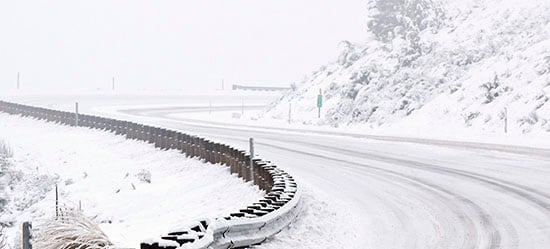Trucks move 99% of the consumer goods that we find on store shelves. Every day the nation’s freight system moves 48 million tons of goods worth $46 billion. Severe weather has a huge impact on the speed, and therefore the profits, of this industry. But the stakes are even higher for truck drivers, because the consequences of bad weather can be deadly.

Winter Is Coming
In these halcyon days of late summer, winter weather seems like nothing more than an unpleasant memory. But winter is right around the corner. And nearly half of all injuries suffered by truck drivers happen during the winter.
In March of 2017 a record-setting blizzard dumped 15 inches of snow on Quebec. Seven people lost their lives, including a truck driver who was involved in a seven-vehicle crash.
And truck drivers’ winter-weather injures go beyond road accidents. Ice and snow cause slips and falls in and around trucks, just as they do in parking lots and residential driveways. Muscle sprains and strains are also a hazard from pushing and pulling on equipment that might not work as well in freezing temperatures.
Wet Roads, High Winds
Severe weather doesn’t only affect truck drivers during the winter. Weather events are a factor in about 1.2 million crashes all throughout the year.

Wet pavement caused by rainfall accounts for the majority of these accidents – 73%. But high winds are another hazard that drivers often overlook. Because semi-trailers have so much surface area, trucks can overturn. When a trailer is empty, the risk is even higher.
The Federal Motor Carrier Safety Administration has rules in place to address severe weather. When hazardous condition exist, truck drivers are required to use “extreme caution in the operation of a commercial motor vehicle.” And if conditions are “sufficiently dangerous,” drivers are required to cease operations altogether.
High-Tech Solutions
In the days before smartphones, truck drivers’ options for staying safe in severe weather were more limited. But now there are a variety of tools available for getting hyper-local information about severe weather, as well as accidents and road closures.
33% of truck drivers use mobile apps to monitor weather and traffic conditions. NOAA Weather Radar is a popular app that drivers in industry forums speak highly of and recommend to each other.
Another is the app made by Accuweather. It includes a feature that provides minute-by-minute forecasts based on the user’s GPS location.
These smartphone weather apps are useful for all motorists, not just truck drivers. But there are some high-tech tools that are more specific to the distribution industry.
Weather visualization applications allow fleet managers to overlay weather data with road condition information for more responsive route planning. These tools do a lot more than just show where precipitation is falling. They display data on temperature, wind speed, and lightning, as well as surface conditions.
With all of the weather-related tools currently available, the trucking industry is getting safer and more efficient every year. But the best way to stay safe on the road is to keep alert. When in doubt, always slow down or stop. It’s the simplest safety rule, but it’s also one of the best.
Sources: MLive.com, CBC.ca, TruckingInfo.com, Ginarte.com, TruckAccidentsAttorneysRoundtable.com, FleetOwner.com, Rita.dot.gov

“Helping our clients get jobs done since 1998.”